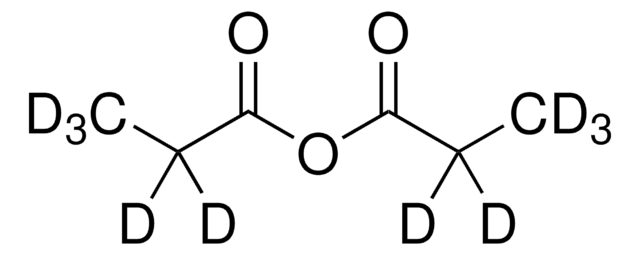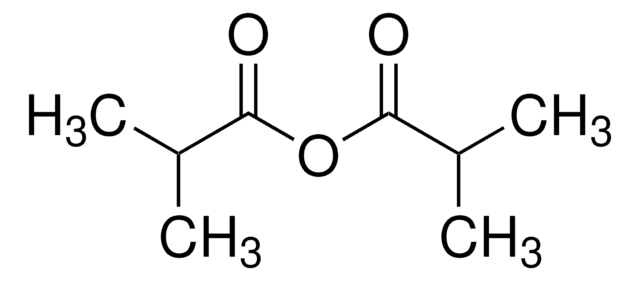Products may be shipped at a different temperature than the recommended long-term storage temperature. If the product quality is sensitive to short-term exposure to conditions other than the recommended long-term storage, it will be shipped on wet or dry-ice. If the product quality is NOT affected by short-term exposure to conditions other than the recommended long-term storage, it will be shipped at ambient temperature. As shipping routes are configured for minimum transit times, shipping at ambient temperature helps control shipping costs for our customers. For more information, please refer to the Storage and Transport Conditions document: https://www.sigmaaldrich.com/deepweb/assets/sigmaaldrich/marketing/global/documents/316/622/storage-transport-conditions-mk.pdf
240311
Propionic anhydride
≥99%
Synonym(s):
Propanoic anhydride
Select a Size
About This Item
Recommended Products
vapor density
4.5 (vs air)
vapor pressure
10 mmHg ( 57.7 °C)
Assay
≥99%
form
liquid
autoignition temp.
545 °F
expl. lim.
11.9 %
refractive index
n20/D 1.404 (lit.)
bp
167 °C (lit.)
mp
−43 °C (lit.)
solubility
chloroform: soluble(lit.)
diethyl ether: soluble(lit.)
ethanol: soluble(lit.)
methanol: soluble(lit.)
density
1.015 g/mL at 25 °C (lit.)
functional group
anhydride
ester
SMILES string
CCC(=O)OC(=O)CC
InChI
1S/C6H10O3/c1-3-5(7)9-6(8)4-2/h3-4H2,1-2H3
InChI key
WYVAMUWZEOHJOQ-UHFFFAOYSA-N
Looking for similar products? Visit Product Comparison Guide
Related Categories
Application
Signal Word
Danger
Hazard Statements
Precautionary Statements
Hazard Classifications
Eye Dam. 1 - Skin Corr. 1B
Storage Class Code
8A - Combustible corrosive hazardous materials
WGK
WGK 1
Flash Point(F)
165.2 °F - closed cup
Flash Point(C)
74 °C - closed cup
Personal Protective Equipment
Choose from one of the most recent versions:
Already Own This Product?
Find documentation for the products that you have recently purchased in the Document Library.
Customers Also Viewed
-
How is shipping temperature determined? And how is it related to the product storage temperature?
1 answer-
Helpful?
-
-
How can I determine the shelf life / expiration / retest date of this product?
1 answer-
If this product has an expiration or retest date, it will be shown on the Certificate of Analysis (COA, CofA). If there is no retest or expiration date listed on the product's COA, we do not have suitable stability data to determine a shelf life. For these products, the only date on the COA will be the release date; a retest, expiration, or use-by-date will not be displayed.
For all products, we recommend handling per defined conditions as printed in our product literature and website product descriptions. We recommend that products should be routinely inspected by customers to ensure they perform as expected.
For products without retest or expiration dates, our standard warranty of 1 year from the date of shipment is applicable.
For more information, please refer to the Product Dating Information document: https://www.sigmaaldrich.com/deepweb/assets/sigmaaldrich/marketing/global/documents/449/386/product-dating-information-mk.pdfHelpful?
-
-
could you provide Grade of the propinicanhydride
1 answer-
This is a research-grade product. It is used as an organic building block in organic synthesis. This product is assigned a quality level of 200. It is intended for research use only. For more information regarding the quality levels within the M-Clarity program see the link below:
https://www.sigmaaldrich.com/US/en/life-science/quality-and-regulatory-management/m-clarity-programHelpful?
-
Active Filters
Our team of scientists has experience in all areas of research including Life Science, Material Science, Chemical Synthesis, Chromatography, Analytical and many others.
Contact Technical Service










![(2R)-2-Phenyl-3,4-dihydro-2H-pyrimido[2,1-b][1,3]benzothiazole ≥95%](/deepweb/assets/sigmaaldrich/product/structures/302/833/59a06b8b-9e9d-4dc4-a4ed-a36ab5081792/640/59a06b8b-9e9d-4dc4-a4ed-a36ab5081792.png)
